Variable Rate Nitrogen and Water Management for Irrigated Maize in the Western US
Abstract
:1. Introduction
2. Materials and Methods
2.1. Site Description
2.2. Experimental Design
2.3. Proximal Canopy Sensing
2.4. Statistical Analysis
2.4.1. Zone, Nitrogen and Water Effects
2.4.2. Four N Management Strategies
- (i)
- For the “uniform” N management strategy, yield observations were sub-sampled corresponding to uniform N rate of 224 kg N ha−1 independent of management zones.
- (ii)
- For the management zone N strategy (MZ), yield observations were sub-sampled based on their location within management zones 1, 2, or 3. For zone 1, yield observations corresponded to a lower level of N application and a high level of N for zone 3.
- (iii)
- For the proximal sensor-based N strategy (RS), a multi-step process was employed to prepare the yield dataset as follows: (a) Measured NDVI values were assigned to each yield pixel (21 m2). (b) The NDVI dataset was then classified using a k-means clustering algorithm (R Development Core Team, 2012) leading to five NDVI classes. (c) Each NDVI class was grouped with a level of N rate such that low NDVI classes were paired with a high level of N and vice versa for high NDVI classes.
- (iv)
- For the fourth N management strategy, remote sensing within zones (MZRS), steps (a) and (b) of strategy (iii) were performed within management zones leading to three NDVI classes per zone. These three NDVI classes within each management zone were grouped with corresponding levels of N such that low levels of N rate were grouped in zone 1 and high levels of N rate in zone 3.
3. Results
3.1. Weather Summary during the Study Period
3.2. Summary Statistics
3.3. Effect of Zone, Nitrogen and Irrigation Rates on Maize Yield
3.3.1. Zone and Irrigation Interaction
3.3.2. Zone and Nitrogen Interaction
3.3.3. Irrigation and Nitrogen Interaction
3.4. Nitrogen Management Strategies
4. Discussion
5. Conclusions
Supplementary Materials
Author Contributions
Funding
Conflicts of Interest
References
- National Agricultural Statistics Service-United States Department of Agriculture (NASS-USDA) NASS-National Agricultural Statistics Service. Available online: http://www.nass.usda.gov/ (accessed on 6 July 2020).
- Tilman, D.; Cassman, K.G.; Matson, P.A.; Naylor, R.; Polasky, S. Agricultural sustainability and intensive production practices. Nature 2002, 418, 671–677. [Google Scholar] [CrossRef] [PubMed]
- De Lara, A.; Khosla, R.; Longchamps, L. Characterizing spatial variability in soil water content for precision irrigation management. Agronomy 2018, 8, 59. [Google Scholar] [CrossRef] [Green Version]
- Delgado, J.; Khosla, R.; Bausch, W.; Westfall, D.; Inman, D. Nitrogen fertilizer management based on site-specific management zones reduces potential for nitrate leaching. J. Soil Water Conserv. 2005, 60, 402–410. [Google Scholar]
- Sun, M.; Huo, Z.; Zheng, Y.; Dai, X.; Feng, S.; Mao, X. Quantifying long-term responses of crop yield and nitrate leaching in an intensive farmland using agro-eco-environmental model. Sci. Total Environ. 2018, 613, 1003–1012. [Google Scholar] [CrossRef]
- Hedley, C. The role of precision agriculture for improved nutrient management on farms. J. Sci. Food Agric. 2015, 95, 12–19. [Google Scholar] [CrossRef]
- Koch, B.; Khosla, R.; Frasier, W.; Westfall, D.; Inman, D. Economic feasibility of variable-rate nitrogen application utilizing site-specific management zones. Agron. J. 2004, 96, 1572–1580. [Google Scholar] [CrossRef] [Green Version]
- Khosla, R.; Shaver, T. Zoning in on nitrogen needs. Colo. State Univ. Agron. Newsl. 2001, 21, 24–26. [Google Scholar]
- Scharf, P.C.; Lory, J.A. Calibrating corn color from aerial photographs to predict sidedress nitrogen need. Agron. J. 2002, 94, 397–404. [Google Scholar] [CrossRef]
- Raun, W.R.; Schepers, J. Nitrogen management for improved use efficiency. Nitrogen Agric. Syst. 2008, 675–693. [Google Scholar]
- Stewart, B.; Lal, R. The nitrogen dilemma: Food or the environment. J. Soil Water Conserv. 2017, 72, 124–128. [Google Scholar] [CrossRef] [Green Version]
- Inman, D.; Khosla, R.; Westfall, D.; Reich, R. Nitrogen uptake across site specific management zones in irrigated corn production systems. Agron. J. 2005, 97, 169–176. [Google Scholar] [CrossRef]
- Khosla, R.; Fleming, K.; Delgado, J.; Shaver, T.; Westfall, D. Use of site-specific management zones to improve nitrogen management for precision agriculture. J. Soil Water Conserv. 2002, 57, 513–518. [Google Scholar]
- Joshi, V.R.; Thorp, K.R.; Coulter, J.A.; Johnson, G.A.; Porter, P.M.; Strock, J.S.; Garcia y Garcia, A. Improving site-specific maize yield estimation by integrating satellite multispectral data into a crop model. Agronomy 2019, 9, 719. [Google Scholar] [CrossRef] [Green Version]
- Reyes, J.; Wendroth, O.; Matocha, C.; Zhu, J. Delineating site-specific management zones and evaluating soil water temporal dynamics in a farmer’s field in Kentucky. Vadose Zone J. 2019, 18, 1–19. [Google Scholar] [CrossRef]
- Fleming, K.; Heermann, D.; Westfall, D. Evaluating soil color with farmer input and apparent soil electrical conductivity for management zone delineation. Agron. J. 2004, 96, 1581–1587. [Google Scholar] [CrossRef]
- Flowers, M.; Weisz, R.; White, J.G. Yield-based management zones and grid sampling strategies. Agron. J. 2005, 97, 968–982. [Google Scholar] [CrossRef]
- Gavioli, A.; de Souza, E.G.; Bazzi, C.L.; Schenatto, K.; Betzek, N.M. Identification of management zones in precision agriculture: An evaluation of alternative cluster analysis methods. Biosyst. Eng. 2019, 181, 86–102. [Google Scholar] [CrossRef]
- Song, X.; Wang, J.; Huang, W.; Liu, L.; Yan, G.; Pu, R. The delineation of agricultural management zones with high resolution remotely sensed data. Precis. Agric. 2009, 10, 471–487. [Google Scholar] [CrossRef]
- Fereres, E.; Connor, D. Sustainable water management in agriculture. In Challenges of the New Water Policies for the XXI Century; AA Balkema: Lisse, The Netherlands, 2004; pp. 157–170. [Google Scholar]
- Tilman, D.; Balzer, C.; Hill, J.; Befort, B.L. Global food demand and the sustainable intensification of agriculture. Proc. Natl. Acad. Sci. USA 2011, 108, 20260–20264. [Google Scholar] [CrossRef] [Green Version]
- Trnka, M.; Kersebaum, K.C.; Eitzinger, J.; Hayes, M.; Hlavinka, P.; Svoboda, M.; Dubrovský, M.; Semerádová, D.; Wardlow, B.; Pokorný, E. Consequences of climate change for the soil climate in Central Europe and the central plains of the United States. Clim. Change 2013, 120, 405–418. [Google Scholar] [CrossRef] [Green Version]
- Trnka, M.; Feng, S.; Semenov, M.A.; Olesen, J.E.; Kersebaum, K.C.; Rötter, R.P.; Semerádová, D.; Klem, K.; Huang, W.; Ruiz-Ramos, M. Mitigation efforts will not fully alleviate the increase in water scarcity occurrence probability in wheat-producing areas. Sci. Adv. 2019, 5, 12. [Google Scholar] [CrossRef] [PubMed] [Green Version]
- Feng, S.; Trnka, M.; Hayes, M.; Zhang, Y. Why do different drought indices show distinct future drought risk outcomes in the US Great Plains? J. Clim. 2017, 30, 265–278. [Google Scholar] [CrossRef]
- Evans, R.G.; LaRue, J.; Stone, K.C.; King, B.A. Adoption of site-specific variable rate sprinkler irrigation systems. Irrig. Sci. 2013, 31, 871–887. [Google Scholar] [CrossRef]
- De Lara, A.; Longchamps, L.; Khosla, R. Soil water content and high-resolution imagery for precision irrigation: Maize yield. Agronomy 2019, 9, 174. [Google Scholar] [CrossRef] [Green Version]
- Barker, J.B.; Heeren, D.M.; Neale, C.M.; Rudnick, D.R. Evaluation of variable rate irrigation using a remote-sensing-based model. Agric. Water Manag. 2018, 203, 63–74. [Google Scholar] [CrossRef] [Green Version]
- Lo, T.H.; Heeren, D.M.; Mateos, L.; Luck, J.D.; Martin, D.L.; Miller, K.A.; Barker, J.B.; Shaver, T.M. Field characterization of field capacity and root zone available water capacity for variable rate irrigation. Appl. Eng. Agric. 2017, 33, 559–572. [Google Scholar] [CrossRef]
- Roygard, J.K.; Alley, M.M.; Khosla, R. No-till corn yields and water balance in the mid-atlantic coastal plain. Agron. J. 2002, 94, 612–623. [Google Scholar]
- Hati, K.; Mandal, K.; Misra, A.; Ghosh, P.; Acharya, C. Evapo-transpiration, water-use efficiency, moisture use and yield of Indian mustard (Brassica juncea) under varying levels of irrigation and nutrient management in Vertisol. Indian J. Agric. Sci. 2001, 71, 639–643. [Google Scholar]
- Pandey, R.; Maranville, J.; Admou, A. Deficit irrigation and nitrogen effects on maize in a Sahelian environment: I. Grain yield and yield components. Agric. Water Manag. 2000, 46, 1–13. [Google Scholar] [CrossRef]
- Ge, Y.; Thomasson, J.A.; Sui, R. Remote sensing of soil properties in precision agriculture: A review. Front. Earth Sci. 2011, 5, 229–238. [Google Scholar] [CrossRef]
- Inman, D.; Khosla, R.; Mayfield, T. On-the-go active remote sensing for efficient crop nitrogen management. Sens. Rev. 2005, 25, 209–214. [Google Scholar] [CrossRef]
- Raun, W.; Johnson, G.; Sembiring, H.; Lukina, E.; LaRuffa, J.; Thomason, W.; Phillips, S.; Solie, J.; Stone, M.; Whitney, R. Indirect measures of plant nutrients. Commun. Soil Sci. Plan. 1998, 29, 1571–1581. [Google Scholar] [CrossRef]
- Shaver, T.; Khosla, R.; Westfall, D. Evaluation of two ground-based active crop canopy sensors in maize: Growth stage, row spacing, and sensor movement speed. Soil Sci. Soc. Am. J. 2010, 74, 2101–2108. [Google Scholar] [CrossRef]
- Longchamps, L.; Khosla, R. Early detection of nitrogen variability in maize using fluorescence. Agron. J. 2014, 106, 511–518. [Google Scholar] [CrossRef]
- Siqueira, R.; Longchamps, L.; Dahal, S.; Khosla, R. Use of fluorescence sensing to detect nitrogen and potassium variability in maize. Remote Sens. 2020, 12, 1752. [Google Scholar] [CrossRef]
- Hatfield, J.; Gitelson, A.A.; Schepers, J.S.; Walthall, C. Application of spectral remote sensing for agronomic decisions. Agron. J. 2008, 100, 117–131. [Google Scholar] [CrossRef] [Green Version]
- Naser, M.A.; Khosla, R.; Longchamps, L.; Dahal, S. Using NDVI to differentiate wheat genotypes productivity under dryland and irrigated conditions. Remote Sens. 2020, 12, 824. [Google Scholar] [CrossRef] [Green Version]
- Naser, M.A.; Khosla, R.; Longchamps, L.; Dahal, S. Characterizing variation in nitrogen use efficiency in wheat genotypes using proximal canopy sensing for sustainable wheat production. Agronomy 2020, 10, 773. [Google Scholar] [CrossRef]
- Roberts, D.F.; Ferguson, R.B.; Kitchen, N.R.; Adamchuk, V.I.; Shanahan, J.F. Relationships between soil-based management zones and canopy sensing for corn nitrogen management. Agron. J. 2012, 104, 119–129. [Google Scholar] [CrossRef] [Green Version]
- Cordero, E.; Longchamps, L.; Khosla, R.; Sacco, D. Spatial management strategies for nitrogen in maize production based on soil and crop data. Sci. Total Environ. 2019, 697, 133854. [Google Scholar] [CrossRef]
- Peralta, N.R.; Costa, J.L.; Balzarini, M.; Angelini, H. Delineation of management zones with measurements of soil apparent electrical conductivity in the southeastern pampas. Can. J. Soil Sci. 2013, 93, 205–218. [Google Scholar] [CrossRef]
- Natural Resources Conservation Service (NRCS). Soil Survey Staff. Natural resources conservation service, United States department of agriculture. In Soil Survey Geographic (SSURGO) Database for Northeast Tennessee; Natural Resources Conservation Service: Washington, DC, USA, 2010. [Google Scholar]
- Ritchie, S.; Hanway, J.; Benson, G. How a corn plant develops. Iowa State Univ. Coop. Ext. Serv. Spec. Rep. 1993, 48, 21. [Google Scholar]
- Andales, A.; Bauder, T.; Arabi, M. A mobile irrigation water management system using a collaborative GIS and weather station networks. In Practical Applications of Agricultural System Models to Optimize the Use of Limited Water; Ahuja, L.R., Ma, L., Lascano, R.J., Eds.; ASA, CSSA, SSSA: Madison, WI, USA, 2014; Volume 5, pp. 53–84. [Google Scholar]
- Walter, I.A.; Allen, R.G.; Elliott, R.; Jensen, M.; Itenfisu, D.; Mecham, B.; Howell, T.; Snyder, R.; Brown, P.; Echings, S. ASCE’s standardized reference evapotranspiration equation. In Proceedings of the Watershed Management and Operations Management 2000, Fort Collins, CO, USA, 20–24 June 2000; pp. 1–11. [Google Scholar]
- Khosla, R.; Flynn, B. Understanding and cleaning yield monitor data. Soil Sci. Step Step Field Anal. 2008, 113–130. [Google Scholar]
- De Mendiburu, F. Package ‘agricolae’. R Package Version (2020): 1–2. Available online: https://cran.r-project.org/web/packages/agricolae/index.html (accessed on 16 June 2020).
- Michalczyk, A.; Kersebaum, K.C.; Roelcke, M.; Hartmann, T.; Yue, S.-C.; Chen, X.-P.; Zhang, F.-S. Model-based optimisation of nitrogen and water management for wheat-maize systems in the North China Plain. Nutr. Cycl. Agroecosyst. 2014, 98, 203–222. [Google Scholar] [CrossRef]
- Kanwar, R.S.; Baker, J.L.; Mukhtar, S. Excessive soil water effects at various stages of development on the growth and yield of corn. Trans. Asae 1988, 31, 133–141. [Google Scholar] [CrossRef] [Green Version]
- Rathore, V.S.; Nathawat, N.S.; Bhardwaj, S.; Sasidharan, R.P.; Yadav, B.M.; Kumar, M.; Santra, P.; Yadava, N.D.; Yadav, O.P. Yield, water and nitrogen use efficiencies of sprinkler irrigated wheat grown under different irrigation and nitrogen levels in an arid region. Agric. Water Manag. 2017, 187, 232–245. [Google Scholar] [CrossRef]
- Stone, K.; Camp, C.; Sadler, E.; Evans, D.; Millen, J. Corn yield response to nitrogen fertilizer and irrigation in the southeastern Coastal Plain. Appl. Eng. Agric. 2010, 26, 429–438. [Google Scholar] [CrossRef]
- Zhang, H. Improving water productivity through deficit irrigation: Examples from Syria, the North China Plain and Oregon, USA. In Water Productivity in Agriculture: Limits and Opportunities for Improvements; CABI: Wallingford, UK, 2003; pp. 301–309. [Google Scholar]
- Gowda, P.H.; Chavez, J.L.; Colaizzi, P.D.; Evett, S.R.; Howell, T.A.; Tolk, J.A. ET mapping for agricultural water management: Present status and challenges. Irrig. Sci. 2008, 26, 223–237. [Google Scholar] [CrossRef] [Green Version]
- Hornung, A.; Khosla, R.; Reich, R.; Inman, D.; Westfall, D. Comparison of site-specific management zones. Agron. J. 2006, 98, 407–415. [Google Scholar] [CrossRef] [Green Version]
- Ferguson, R.B.; Hergert, G.W.; Schepers, J.; Gotway, C.; Cahoon, J.; Peterson, T. Site-specific nitrogen management of irrigated maize. Soil Sci. Soc. Am. J. 2002, 66, 544–553. [Google Scholar]
- Del Pilar, M.M.-P.; Cipriotti, P.A.; Urricariet, S.; Peralta, N.R.; Niborski, M. Using site-specific nitrogen management in rainfed corn to reduce the risk of nitrate leaching. Agric. Water Manag. 2018, 199, 61–70. [Google Scholar]
- Peralta, N.R.; Assefa, Y.; Du, J.; Barden, C.J.; Ciampitti, I.A. Mid-season high-resolution satellite imagery for forecasting site-specific corn yield. Remote Sens. 2016, 8, 848. [Google Scholar] [CrossRef] [Green Version]
- Ahmad, I.; Wajid, S.A.; Ahmad, A.; Cheema, M.J.M.; Judge, J. Optimizing irrigation and nitrogen requirements for maize through empirical modeling in semi-arid environment. Environ. Sci. Pollut. Res. 2019, 26, 1227–1237. [Google Scholar] [CrossRef] [PubMed]
- Hammad, H.M.; Farhad, W.; Abbas, F.; Fahad, S.; Saeed, S.; Nasim, W.; Bakhat, H.F. Maize plant nitrogen uptake dynamics at limited irrigation water and nitrogen. Environ. Sci. Pollut. Res. 2017, 24, 2549–2557. [Google Scholar] [CrossRef] [PubMed]
- Wang, Y.; Janz, B.; Engedal, T.; de Neergaard, A. Effect of irrigation regimes and nitrogen rates on water use efficiency and nitrogen uptake in maize. Agric. Water Manag. 2017, 179, 271–276. [Google Scholar] [CrossRef] [Green Version]
- Ogola, J.; Wheeler, T.; Harris, P. Effects of nitrogen and irrigation on water use of maize crops. Field Crop. Res. 2002, 78, 105–117. [Google Scholar] [CrossRef]
- Holland, K.; Schepers, J. Derivation of a variable rate nitrogen application model for in-season fertilization of corn. Agron. J. 2010, 102, 1415–1424. [Google Scholar] [CrossRef]
- Inman, D.; Khosla, R.; Reich, R.; Westfall, D. Normalized difference vegetation index and soil color-based management zones in irrigated maize. Agron. J. 2008, 100, 60–66. [Google Scholar] [CrossRef]
- Schwalbert, R.; Amado, T.J.; Horbe, T.A.; Stefanello, L.O.; Assefa, Y.; Prasad, P.; Rice, C.W.; Ciampitti, I.A. Corn yield response to plant density and nitrogen: Spatial models and yield distribution. Agron. J. 2018, 110, 970–982. [Google Scholar] [CrossRef]
- Holland, K.H.; Schepers, J.S. Use of a virtual-reference concept to interpret active crop canopy sensor data. Precis. Agric. 2013, 14, 71–85. [Google Scholar] [CrossRef]
- Raun, W.; Solie, J.; Stone, M.; Martin, K.; Freeman, K.; Mullen, R.; Zhang, H.; Schepers, J.; Johnson, G. Optical sensor-based algorithm for crop nitrogen fertilization. Commun. Soil Sci. Plan. 2005, 36, 2759–2781. [Google Scholar] [CrossRef] [Green Version]
- Sobota, D.J.; Compton, J.E.; McCrackin, M.L.; Singh, S. Cost of reactive nitrogen release from human activities to the environment in the United States. Environ. Res. Lett. 2015, 10, 025006. [Google Scholar] [CrossRef]
- Van Grinsven, H.J.; Holland, M.; Jacobsen, B.H.; Klimont, Z.; Sutton, M.A.; Willems, W.J. Costs and benefits of nitrogen for Europe and implications for mitigation. Environ. Sci. Technol. 2013, 47, 3571–3579. [Google Scholar] [CrossRef] [PubMed]
- Cui, Z.; Shi, L.; Xu, J.; Li, J.; Zhang, F.; Chen, X. Effects of N fertilization on winter wheat grain yield and its crude protein content and apparent N losses. Ying Yong Sheng Tai Xue Bao J. Appl. Ecol. 2005, 16, 2071–2075. [Google Scholar]
- Ying, H.; Ye, Y.; Cui, Z.; Chen, X. Managing nitrogen for sustainable wheat production. J. Clean. Prod. 2017, 162, 1308–1316. [Google Scholar] [CrossRef]
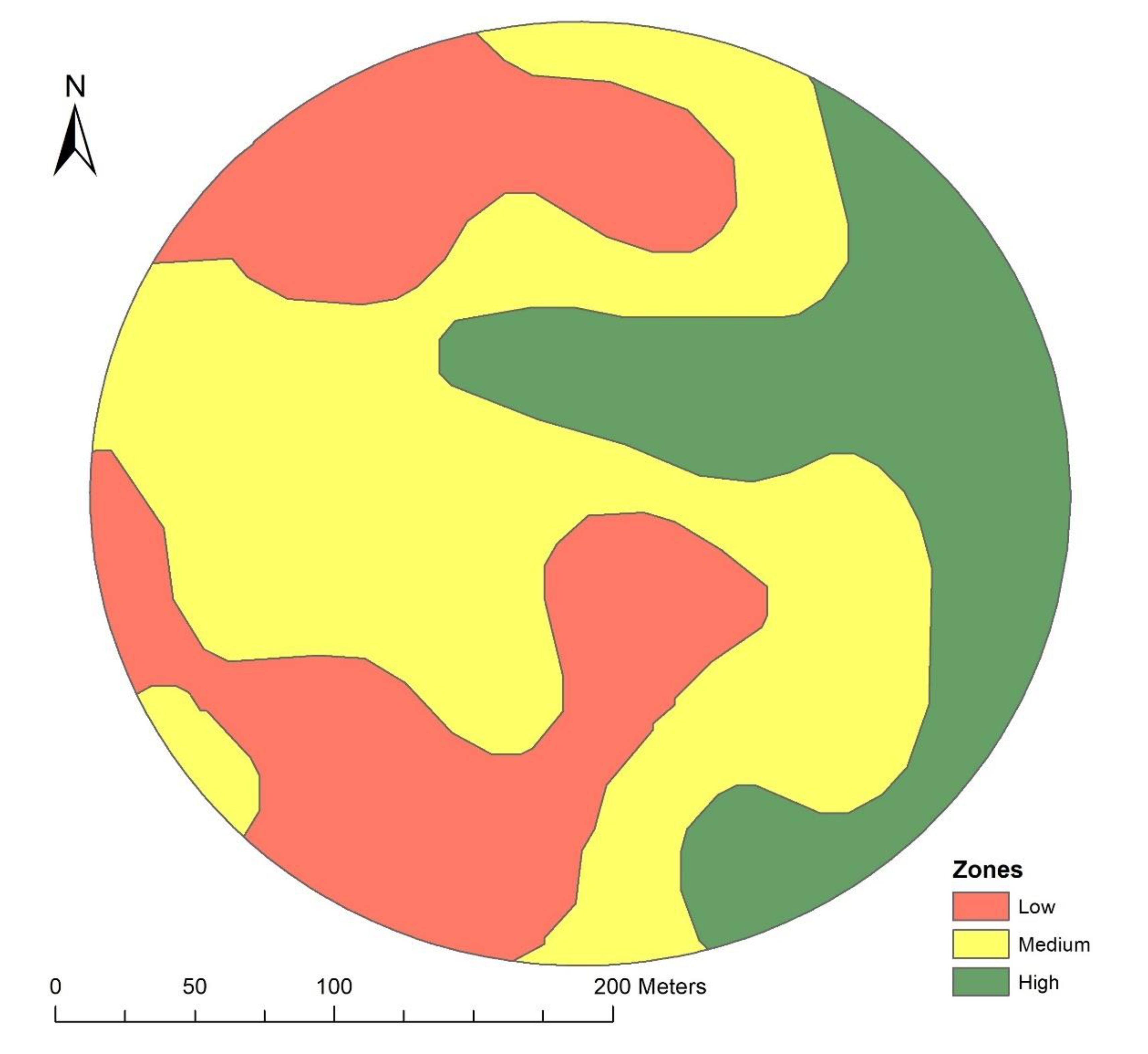
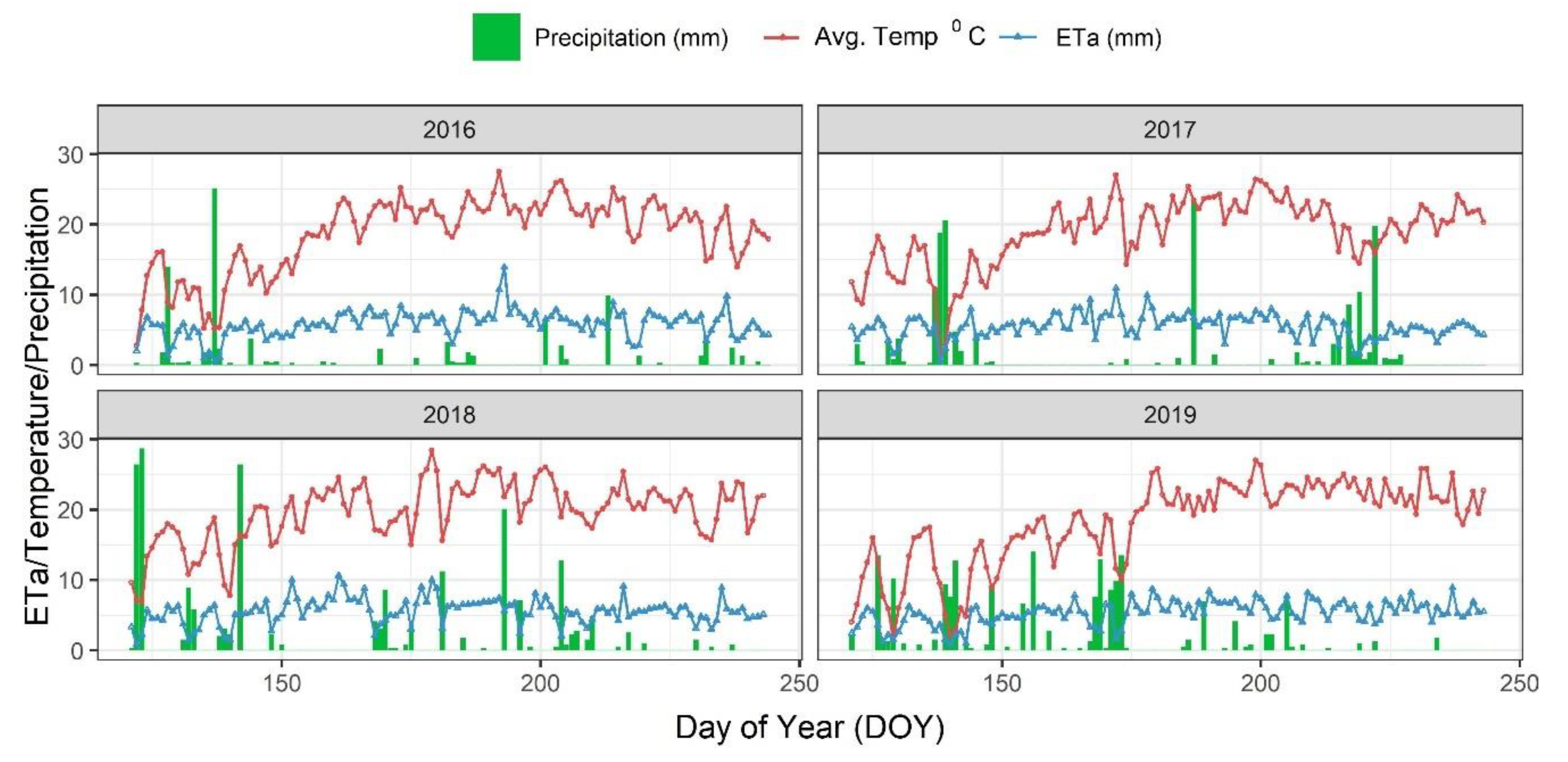

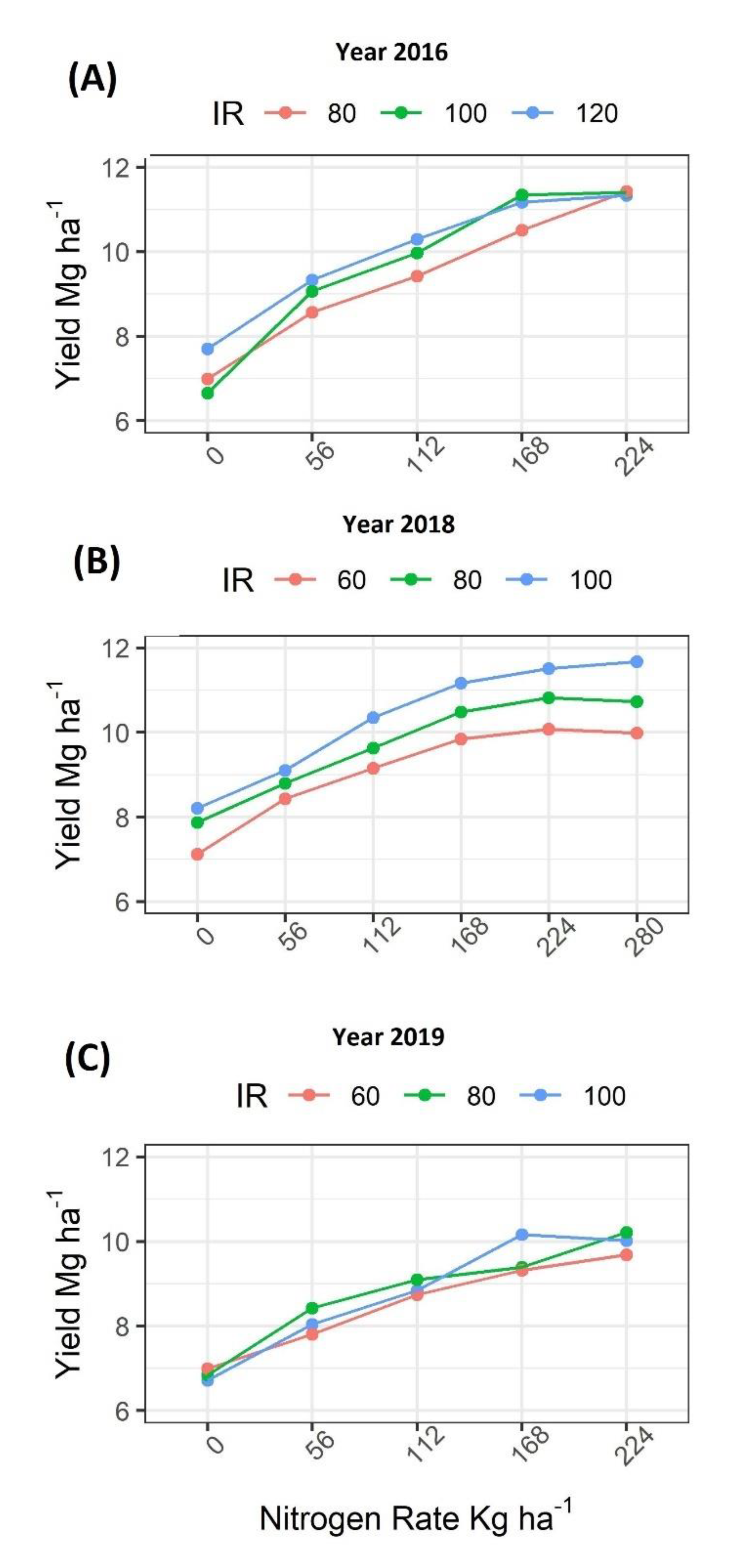
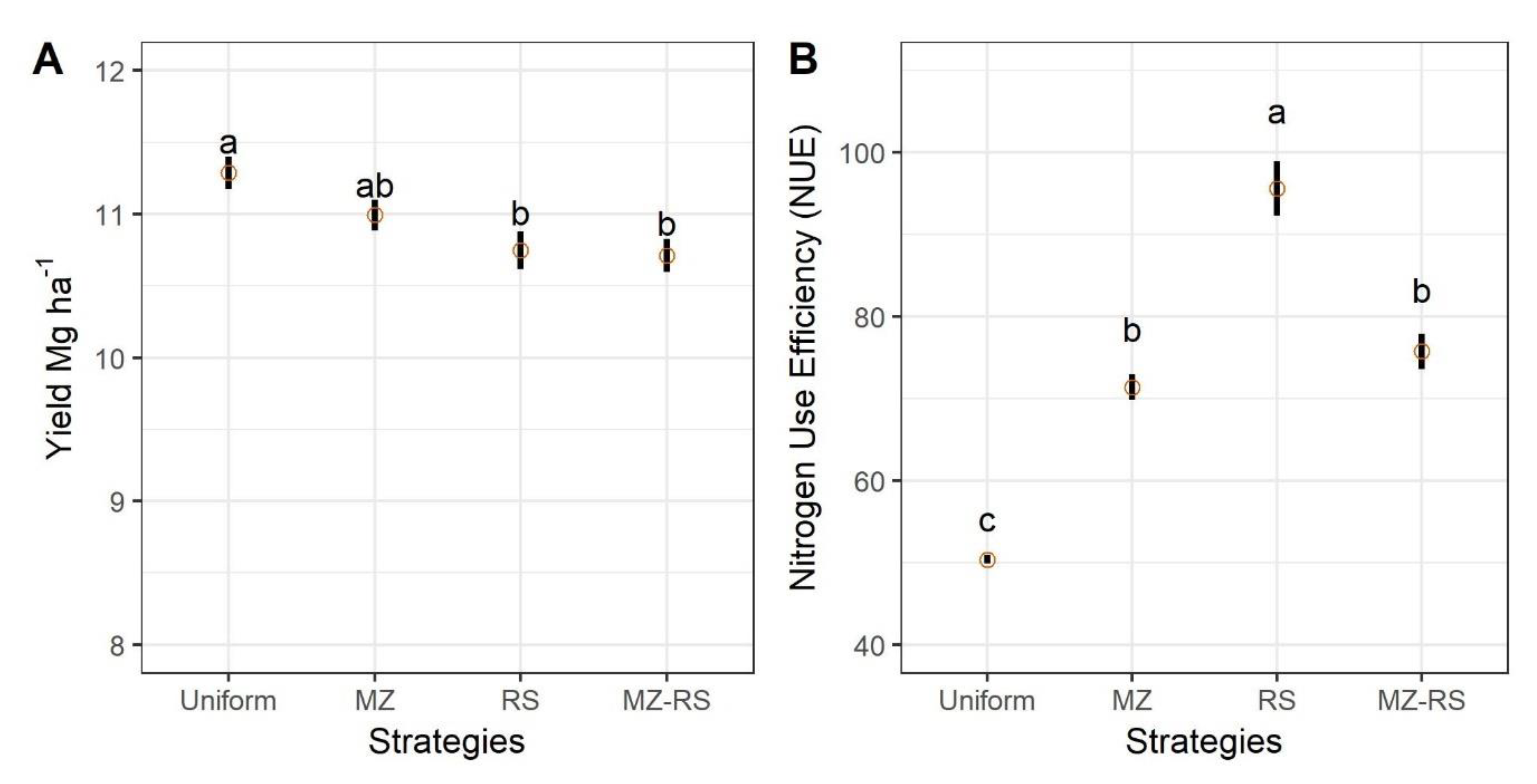
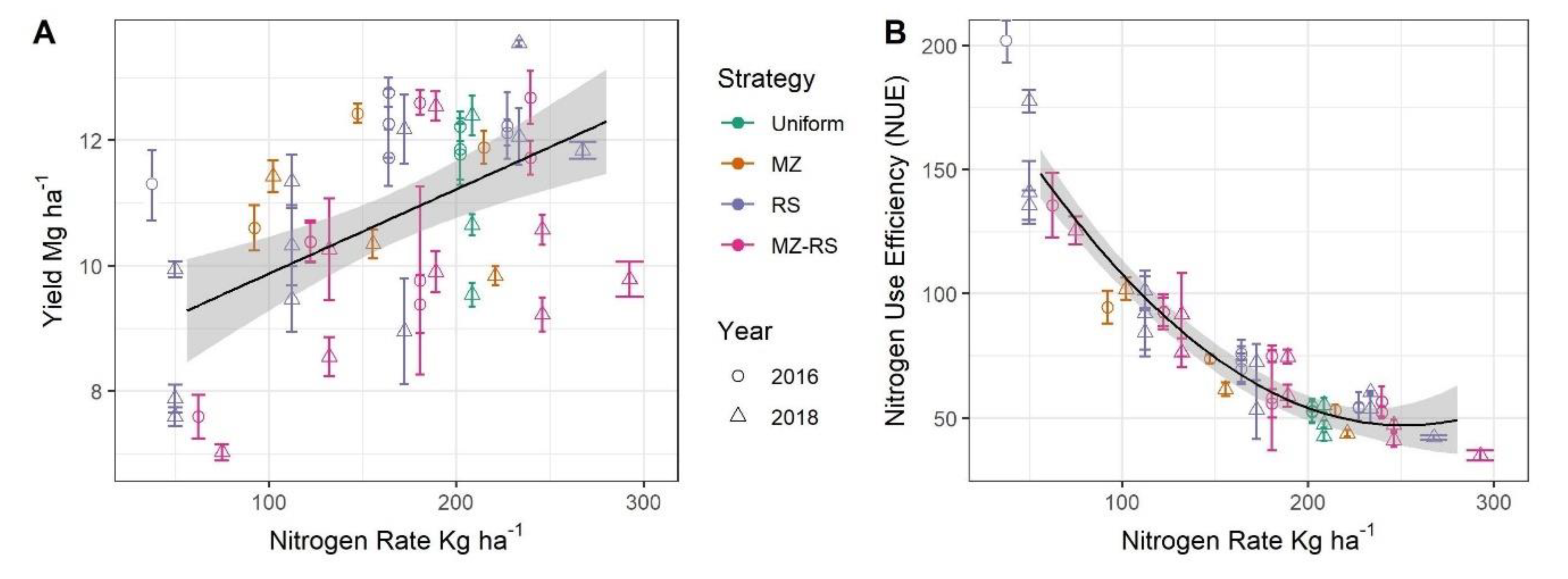
| Strategy | Observations | N Rate (kg N ha−1) | Management Zone | NDVI Cluster | Average N (kg N ha−1) |
|---|---|---|---|---|---|
| Uniform | 270 | 224 | Any | Any | 224 |
| 90 | 112 | Low | Any | ||
| MZ | 90 | 168 | Medium | Any | 168 |
| 90 | 224 | High | Any | ||
| 54 | 56 | Any | Highest | ||
| 54 | 112 | Any | High | ||
| RS | 54 | 168 | Any | Medium | 168 |
| 54 | 224 | Any | Low | ||
| 54 | 280 | Any | Lowest | ||
| 30 | 56 | Low | High | ||
| 30 | 112 | Low | Medium | ||
| 30 | 168 | Low | Low | ||
| 30 | 112 | Medium | High | ||
| MZRS | 30 | 168 | Medium | Medium | 168 |
| 30 | 224 | Medium | Low | ||
| 30 | 168 | High | High | ||
| 30 | 224 | High | Medium | ||
| 30 | 280 | High | Low |
| Year | Zone | N | Mean | Median | Min | Max | SE |
|---|---|---|---|---|---|---|---|
| Nitrogen Rate | |||||||
| 2016 | 0 | 1267 | 7.03 | 7.01 | 1.99 | 10.9 | 0.04 |
| 2016 | 56 | 1352 | 8.75 | 8.84 | 2.08 | 16.2 | 0.06 |
| 2016 | 112 | 1265 | 10.02 | 10.37 | 1.97 | 14.57 | 0.05 |
| 2016 | 168 | 1151 | 11.36 | 11.75 | 1.98 | 17.53 | 0.06 |
| 2016 | 224 | 1055 | 11.62 | 11.86 | 2.1 | 16.94 | 0.05 |
| 2018 | 0 | 542 | 8.04 | 8.14 | 1.93 | 11.54 | 0.07 |
| 2018 | 56 | 498 | 8.8 | 8.96 | 2.2 | 13.2 | 0.07 |
| 2018 | 112 | 493 | 9.95 | 9.5 | 2.09 | 14.79 | 0.1 |
| 2018 | 168 | 486 | 10.77 | 10.72 | 2.61 | 14.53 | 0.08 |
| 2018 | 224 | 479 | 10.85 | 10.63 | 2.92 | 15.05 | 0.08 |
| 2018 | 280 | 487 | 10.87 | 10.86 | 2.05 | 15.02 | 0.08 |
| 2019 | 0 | 229 | 6.74 | 6.56 | 2.05 | 13.57 | 0.08 |
| 2019 | 56 | 515 | 7.99 | 7.99 | 1.88 | 10.6 | 0.05 |
| 2019 | 112 | 258 | 9.28 | 9.47 | 1.89 | 12.47 | 0.11 |
| 2019 | 168 | 513 | 9.58 | 9.51 | 2.27 | 13.2 | 0.06 |
| 2019 | 224 | 407 | 10.09 | 10.2 | 3.42 | 13.76 | 0.06 |
| Irrigation Rate | |||||||
| 2016 | 80 | 2139 | 8.79 | 8.92 | 1.97 | 14.56 | 0.05 |
| 2016 | 100 | 1725 | 10.3 | 10.78 | 1.98 | 16.73 | 0.06 |
| 2016 | 120 | 2226 | 9.96 | 10.32 | 2.16 | 17.53 | 0.05 |
| 2018 | 60 | 1008 | 9.21 | 9 | 2.05 | 15.02 | 0.06 |
| 2018 | 80 | 944 | 9.98 | 9.79 | 1.93 | 14.9 | 0.07 |
| 2018 | 100 | 1033 | 10.34 | 10.55 | 2.09 | 15.05 | 0.07 |
| 2019 | 60 | 643 | 8.86 | 8.9 | 1.92 | 13.2 | 0.07 |
| 2019 | 80 | 657 | 8.88 | 8.99 | 3.14 | 13.57 | 0.06 |
| 2019 | 100 | 622 | 8.92 | 9.01 | 1.88 | 13.76 | 0.07 |
| Zone | |||||||
| 2016 | 1 | 2211 | 9.27 | 9.59 | 1.98 | 17.53 | 0.05 |
| 2016 | 2 | 2922 | 10.19 | 10.52 | 2.07 | 16.94 | 0.04 |
| 2016 | 3 | 957 | 8.86 | 9.03 | 1.97 | 14.56 | 0.08 |
| 2018 | 1 | 908 | 10.67 | 10.72 | 2.05 | 15.05 | 0.08 |
| 2018 | 2 | 1028 | 9.28 | 9.27 | 2.09 | 14.91 | 0.07 |
| 2018 | 3 | 1049 | 9.68 | 9.73 | 1.93 | 13.76 | 0.04 |
| 2019 | 1 | 620 | 8.82 | 8.78 | 2.27 | 12.86 | 0.06 |
| 2019 | 2 | 928 | 8.96 | 9.01 | 3.1 | 13.2 | 0.06 |
| 2019 | 3 | 374 | 8.81 | 9.08 | 1.88 | 13.76 | 0.11 |
| 2016 | 2018 | 2019 | ||||||||||
|---|---|---|---|---|---|---|---|---|---|---|---|---|
| Factors | SS | df | F | p | SS | df | F | p | SS | df | F | p |
| NR | 191.271 | 4 | 24.77 | <0.001 | 28.61 | 5 | 4.57 | 0.0059 | 84.47 | 4 | 16.51 | <0.001 |
| IR | 29.568 | 2 | 7.65 | <0.001 | 651.33 | 2 | 260.07 | <0.001 | 10.15 | 2 | 3.97 | 0.021 |
| Zone | 10.214 | 2 | 2.64 | 0.078 | 3.16 | 2 | 1.26 | 0.301 | 4.25 | 2 | 1.66 | 0.208 |
| NR: IR | 126.491 | 8 | 8.19 | <0.001 | 51.29 | 10 | 4.09 | <0.001 | 47.35 | 8 | 4.63 | <0.001 |
| NR: Zone | 21.102 | 8 | 1.36 | 0.229 | 13.65 | 10 | 1.09 | 0.411 | 23.46 | 8 | 2.29 | 0.052 |
| IR: Zone | 173.035 | 4 | 22.41 | <0.001 | 152.51 | 4 | 30.44 | <0.001 | 33.53 | 4 | 6.55 | <0.001 |
Publisher’s Note: MDPI stays neutral with regard to jurisdictional claims in published maps and institutional affiliations. |
© 2020 by the authors. Licensee MDPI, Basel, Switzerland. This article is an open access article distributed under the terms and conditions of the Creative Commons Attribution (CC BY) license (http://creativecommons.org/licenses/by/4.0/).
Share and Cite
Dahal, S.; Phillippi, E.; Longchamps, L.; Khosla, R.; Andales, A. Variable Rate Nitrogen and Water Management for Irrigated Maize in the Western US. Agronomy 2020, 10, 1533. https://doi.org/10.3390/agronomy10101533
Dahal S, Phillippi E, Longchamps L, Khosla R, Andales A. Variable Rate Nitrogen and Water Management for Irrigated Maize in the Western US. Agronomy. 2020; 10(10):1533. https://doi.org/10.3390/agronomy10101533
Chicago/Turabian StyleDahal, Subash, Evan Phillippi, Louis Longchamps, Raj Khosla, and Allan Andales. 2020. "Variable Rate Nitrogen and Water Management for Irrigated Maize in the Western US" Agronomy 10, no. 10: 1533. https://doi.org/10.3390/agronomy10101533
APA StyleDahal, S., Phillippi, E., Longchamps, L., Khosla, R., & Andales, A. (2020). Variable Rate Nitrogen and Water Management for Irrigated Maize in the Western US. Agronomy, 10(10), 1533. https://doi.org/10.3390/agronomy10101533






